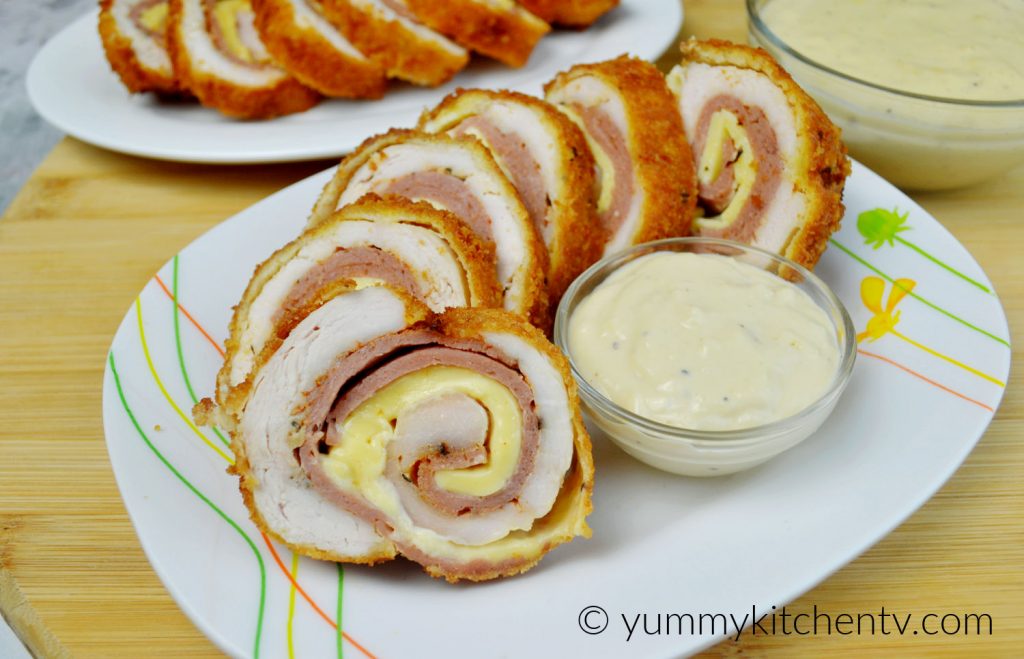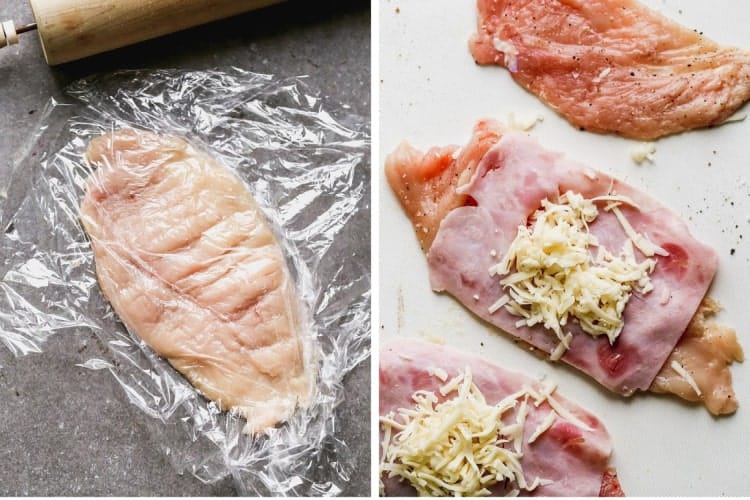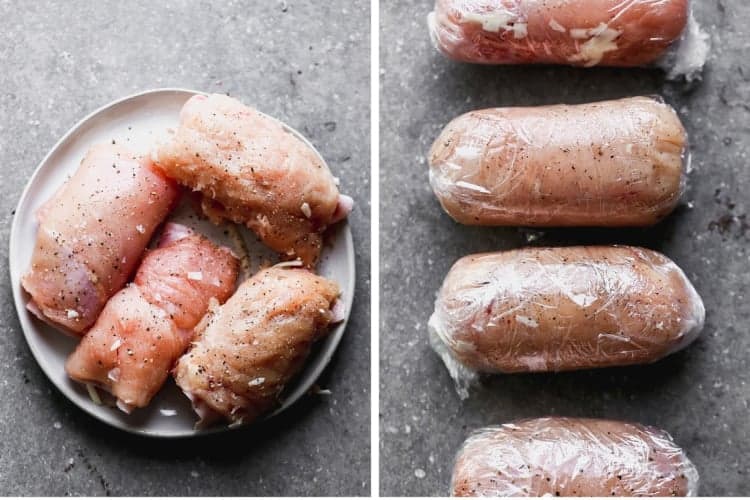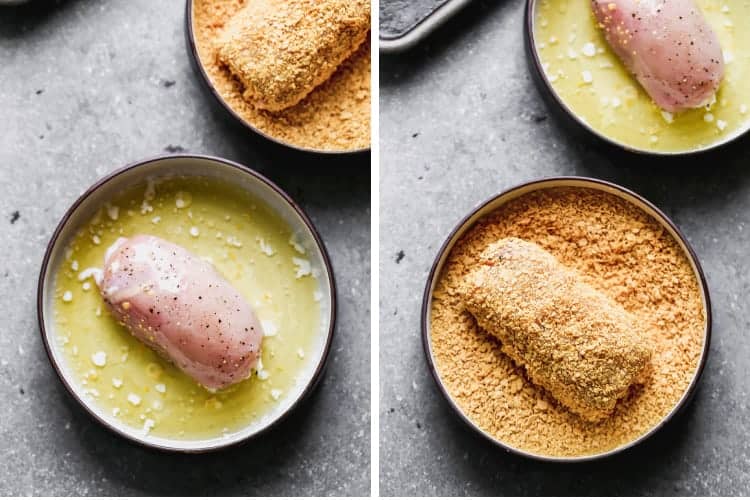Have you ever stared at your plate of chicken cordon bleu and wondered, “Where’s the blue part?” You’re definitely not alone! As a food blogger who’s spent countless hours in the kitchen perfecting this classic dish, I’ve heard this question more times than I can count. Today, I’m gonna clear up this culinary confusion once and for all.
The Surprising Truth Behind The Name
Let’s cut right to the chase – there’s actually no blue cheese in traditional chicken cordon bleu! I know, I was shocked too when I first learned this. The “blue” in the name has nothing to do with blue cheese at all, despite what many people assume.
The term “cordon bleu” actually translates from French as “blue ribbon.” According to culinary history, it refers to a wide blue ribbon worn by members of the highest order of knighthood in France – L’Ordre des chevaliers du Saint-Esprit – established by King Henri III of France way back in 1578.
Over time, the term “cordon bleu” became associated with exceptional cooking and outstanding chefs. The blue ribbon symbolized excellence and high standards – kinda like how we give out blue ribbons at competitions today!
The Real History of Chicken Cordon Bleu
The origins of this delicious dish are a bit debated, but most food historians agree it emerged sometime in the 20th century as an adaptation of veal cordon bleu. The original dish has Swiss roots, dating back to around the 16th century.
Some interesting theories about its origin include
- Created by a female Valaisian cook in Switzerland who needed to feed many guests quickly
- Invented during a cooking competition in France in 1930
- Prepared by a Swiss cook on the German ship SS Bremen in 1933 to celebrate a new record
The earliest actual reference to “veal cordon bleu” appeared in the Los Angeles Times in 1958, while the chicken version gained popularity in America during the 1960s. It’s fascinating how dishes evolve over time, isn’t it?
What’s ACTUALLY In Chicken Cordon Bleu?
Traditional chicken cordon bleu consists of three essential components:
- Chicken Breast – Typically pounded thin to ensure even cooking
- Ham – Thin slices that add a salty, smoky flavor
- Cheese – Usually Swiss or Gruyère (NOT blue cheese!)
The chicken is stuffed with ham and cheese, then breaded and either fried or baked until golden and crispy. The result is a heavenly combination of tender chicken, salty ham, and gooey cheese all wrapped in a crispy coating.
The Cheese Confusion
Many people mistakenly believe blue cheese is part of the recipe because of the name But traditional recipes call for Swiss and Gruyère cheeses, which provide a nutty, melty texture that perfectly complements the chicken and ham
I remember the first time I made chicken cordon bleu at home. I went to the store and specifically looked for blue cheese, only to get home and realize my recipe called for Swiss! Talk about a facepalm moment!
How To Make Classic Chicken Cordon Bleu
If you’re wanting to try making this dish at home (which I highly recommend!) here’s my simplified approach
Ingredients:
- 4 boneless, skinless chicken breasts
- 8 thin slices of ham
- 8 slices of Swiss or Gruyère cheese
- 1 cup flour
- 2 eggs, beaten
- 2 cups panko breadcrumbs
- Salt and pepper to taste
- Oil for frying or baking
Steps:
- Prep the chicken – Pound each breast to about 1/4-inch thickness
- Layer the fillings – Place 2 slices of ham and 2 slices of cheese on each chicken breast
- Roll it up – Carefully roll the chicken, tucking in the sides to secure the filling
- Bread the chicken – Dip in flour, then egg wash, then breadcrumbs
- Cook to perfection – Either pan-fry until golden brown or bake at 375°F for 25-30 minutes
Popular Variations Around the World
While the classic recipe is amazing, there are tons of variations worldwide:
- Chicken Kiev – A Ukrainian variation with garlic butter filling instead of cheese
- Chicken Parmesan – An Italian-American version topped with tomato sauce and Parmesan
- Chicken Katsu – A Japanese adaptation using panko breadcrumbs
- Milanesa rellena – Popular in Uruguay and Argentina, made with beef or chicken fillets
In Muslim countries, halal versions replace pork with beef or mutton, showing how adaptable this dish really is!
Common Questions People Ask About Chicken Cordon Bleu
Why is chicken cordon bleu not blue?
The “blue” refers to the blue ribbon of excellence, not the color of the food.
Can I use blue cheese in chicken cordon bleu?
While not traditional, you absolutely can! I’ve tried it with a small amount of blue cheese mixed with the Swiss, and it adds an interesting tang. Food is meant to be experimented with!
What’s the best cheese for chicken cordon bleu?
Traditionally, a combo of Swiss and Gruyère provides that perfect nutty, melty texture.
How do I stop the cheese from leaking out?
This is a common problem! Make sure you seal the edges of the chicken well, and consider chilling the rolled chicken for 30 minutes before cooking.
My Personal Take on Chicken Cordon Bleu
I’ve been making this dish for years, and let me tell you – it’s a crowd-pleaser! My family requests it for special occasions, and I’ve developed my own little twist by adding a thin layer of Dijon mustard before the ham. It adds just a touch of tangy flavor that complements the richness of the cheese.
The most challenging part for beginners is keeping the cheese from oozing out during cooking. My tip? Wrap the rolled chicken tightly in plastic wrap and refrigerate for at least 30 minutes before breading. This helps everything stay together during cooking.
Sauce Recommendations
While chicken cordon bleu is delicious on its own, a good sauce takes it to the next level! Here are some options:
- Classic Dijon Cream Sauce – Made with butter, flour, milk, Dijon mustard, and Parmesan
- Simple Mayo-Mustard Mix – Equal parts mayonnaise and Dijon mustard stirred together
- Lemon Butter Sauce – Light and bright, perfect for cutting through the richness
Healthier Alternatives
If you’re watching your calories but still craving this classic, try these modifications:
- Skip the breading and just roll the chicken with ham and cheese
- Bake instead of fry
- Use low-fat cheese (though it won’t melt quite as nicely)
- Substitute turkey ham for regular ham
The Bottom Line
So there you have it – the “blue” in chicken cordon bleu has nothing to do with blue cheese! It’s all about that historic blue ribbon representing culinary excellence. Next time someone asks you this question at the dinner table, you’ll be ready with an answer that’ll impress everyone!
Whether you’re a cooking novice or a seasoned chef, chicken cordon bleu is a classic dish worth mastering. And now that you know the story behind the name, you can appreciate it even more.
Have you tried making chicken cordon bleu at home? What’s your favorite variation? I’d love to hear about your experiences in the comments below!
FAQ About Chicken Cordon Bleu
1. Is cordon bleu French or Swiss?
The dish has connections to both countries! While the term “cordon bleu” is French, the dish itself likely originated in Switzerland.
2. Can chicken cordon bleu be made ahead of time?
Absolutely! You can prepare it up to a day in advance and keep it refrigerated until ready to cook.
3. What sides go well with chicken cordon bleu?
My favorites include roasted asparagus, mashed potatoes, or a simple green salad.
4. Can I freeze chicken cordon bleu?
Yes! Freeze them after breading but before cooking. They’ll keep for up to 3 months.
5. Is chicken cordon bleu difficult to make?
It looks fancy but is actually quite approachable! The key is patience when pounding and rolling the chicken.
Now that you know the truth about the “blue” in chicken cordon bleu, go impress your friends with this fascinating bit of culinary trivia!

How to make Chicken Cordon Bleu:
Prep chicken breasts. Use a sharp knife to cut each chicken breast in half horizontally to create two chicken breast halves (or buy already cut chicken breast halves). Place between two sheets of plastic wrap and use a meat mallet or rolling pin to pound them into thin, even pieces (be careful not to pound so hard that the meat tears.).
Top with ham and cheese. Top each pieces of chicken with a slice of ham and a ham handful of shredded cheese.

Roll each up tightly into a bundle, tucking the sides a little, and place on a small square of plastic wrap (this is my trick for how to roll chicken cordon blue tightly, so it stays and doesn’t require toothpicks).
Wrap the chicken bundle up tightly in plastic wrap, pinching the excess plastic on the sides to create a tootsie-roll shape. Twist and swing the ends to create a firm chicken roll (watch video below, for reference).
Refrigerate the wrapped chicken bundles for at least 30-minutes or up to one day in advance, or freeze for up to 3 months..

Add breading: Dip the chicken bundles in melted butter, and then into the cornflake crumbs (you could also use breadcrumbs), pressing lightly to help the crumbs stick to the chicken. Transfer to a lightly greased baking sheet.

Bake on the center oven rack for about 20-25 minutes, or until chicken is cooked through (160 degrees F on a thermometer inserted into the chicken, not the filling.)
Top with sauce. Make the sauce by stirring the mayo and mustard together. Taste and add more mustard, as needed, to taste.

- Cheese: The most popular type of cheese to use when making chicken cordon bleu is Swiss cheese and I love the way it pairs with the ham and chicken. HOWEVER, feel free to substitute any other cheese and I have no doubt the results would be equally as delicious!
- Cornflakes: regular breadcrumbs, Panko, crushed ritz crackers would also work.
- Sauce: I use a very simple sauce for my chicken cordon bleu; mayonnaise and mustard mixed together. This is how we enjoy it in our family, but here is a more traditional chicken cordon bleu sauce recipe if you prefer.

